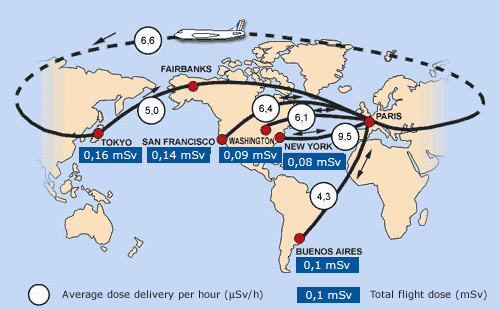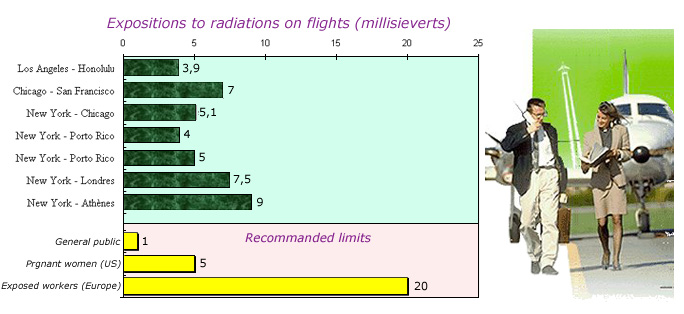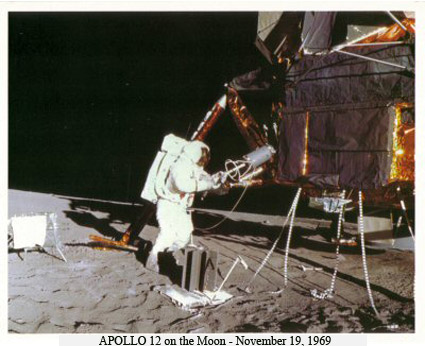Exposure to cosmic rays while flying or in space
The Earth atmosphere and magnetic field combine to form a powerful shield against the radiation emanating from the Sun and all other stars. The atmospheric layers absorb most of the particles generated by the incoming cosmic rays, and the magnetic field that surrounds the Earth is able to deflect a substantial number of those that make it through.
The higher one goes in altitude, the less protection one has from incoming radiations. The Indians of the Andes and the Tibetans in the Himalayas experience relatively large doses of radiations at their height of 3-4,000 metres above sea level. The effect is comparable to that experienced by mountain climbers, skiers and pilots, but is felt over decades rather than hours.

Doses on flights:
Studies done on main flight paths representing different levels of exposure to cosmic rays. Within the small circles, the average dose received every hour is indicated in millionths of Sieverts (µSv) The total dose (in blue) gives the value, in millisieverts, for a return flight (the Paris-New York measurement, in this case, was conducted on a Concorde jet).
© IRSN
These higher doses are in general too small to be dangerous. A passenger flying from London to New York, at a height of 11,000 metres, will receive a dose of 0.032 mSv – the equivalent of a panoramic dental X-ray scan. A passenger travelling from New York to Hong Kong, however, will pass over the North Pole, where the air is thinner and the magnetic field is weaker. As a result, this second passenger will absorb a dose almost three times as large. It would take five such return flights for a passenger or crew member to absorb a dose of even 1 mSv – the amount absorbed by a thigh X-ray.
One millisievert is also the maximum dose recommended by the International Commission on Radiological Protection (ICRP): equivalent to 40% of the average annual exposure rate due to naturally-occurring radiation. One millisievert more or less, however, remains a very weak dose, and it has not yet been proven that it poses any threat. It must be stressed that the maximum dose allowed for nuclear industry workers is of 20 mSv in Europe, and 50 mSv in the United States.
Of all aerial passengers, pregnant women, air crew and frequent flyers are the most at risk. In particular, flight crew are exposed to higher doses of cosmic rays due to their spending more time at high altitudes. A European directive from the year 2000 forces all airlines to keep tabs on the doses absorbed by their crews, and to let them know when it reaches 1 mSv.

Doses for 1000 hours of flight
Radiation levels for crew members after 1000 hours in the air on various flight paths. By comparison, the maximum doses are displayed for members of the public, pregnant women, and nuclear industry workers. These limits do not include exposures to natural radioactivity or due to medicine.
© IN2P3
Similar risks exist for astronauts – though the consequences are less well-known. While on Earth, astronauts are protected by the planet magnetic field. Once they leave its safety, however, their only shield is the wall of their spacecraft. While this is amply sufficient to stop most of the solar particles, high-energy cosmic rays can travel through several metres of metal without being stopped.
In the Apollo missions, 30 astronauts left the Earth protection between 1963 and 1972. Their health has been consistently monitored, and these studies have revealed that symptoms of ageing (such as cataract) occurred approximately seven years earlier than they did on their fellow astronauts who never travelled as far.

Plutonium 238 on the moon
Generators producing electricity through the radioactive decay of plutonium 238 have been used on all the Apollo moon missions. In the picture above, we see astronaut Alan Bean transferring plutonium 238 stored in a RTG (Radioisotope thermic generator) to the surface of the moon. This plutonium 238 was the main source of energy for experiments conducted on the moon’s surface.
© NASA No. MSCL-41
Spaceships cannot do without reliable, long-life energy sources that can be used in space. As a result, unmanned probes designed for long missions far from the Sun embark with a few kilograms of plutonium 238, whose decay provides the necessary energy to power the ships during that travel.